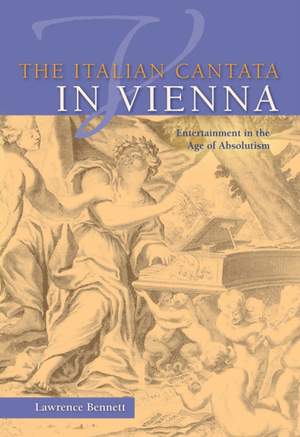The Italian Cantata in Vienna: Entertainment in the Age of Absolutism
- Author: Bennett, Lawrence
By taking multiple analytical approaches, Bennett establishes an overall understanding while also demonstrating how individual composers approached the genre. . . . Recommended — More…
Book
$76.25Contents
- Preface
- List of Bibliographical Abbreviations
- List of RISM Sigla
- 1. Introduction
- The Role of Music in the Daily Lives of the Habsburgs
- The Scope of the Book
- The Secondary Literature
- The Cantata Terminology
- Forerunners of the Cantata in Vienna
- Part I: The Cantata in Vienna, 1658-1700
- 2. The Political and Cultural Milieu
- Historical Background
- Leopold I as Patron and Composer
- Habsburg Music Chapels, 1658-1700
- Occasions, Places of Performance, and Performers
- Librettists
- 3. The Composers
- Composers Who May Have Written Cantatas for Vienna During the Early
- Reign of Leopold I
- Antonio and Carlo Draghi
- Filippo Vismarri
- Carlo Cappellini
- Giovanni Battista Pederzuoli
- Antonio Maria and Giovanni Buonaventura Viviani
- German-Speaking Composers
- 4. Repertoire and Sources
- The Repertoire
- The Sources
- 5. Text and Music
- Antonio Maria Viviani
- Antonio Bertali
- Filippo Vismarri
- Carlo Cappellini
- Giovanni Battista Pederzuoli
- Antonio and Carlo Draghi
- Part II: The Cantata in Vienna, 1700-1711
- 6. The Political and Cultural Milieu
- Historical Background
- Joseph I as Patron and Composer
- Cultural Growth
- Habsburg Music Chapels, 1700-1711
- Genre Designations
- Occasions, Places of Performance, and Performers
- Librettists and Librettos
- 7. The Composers
- Carlo Agostino Badia
- Giovanni Bononcini
- Marc'Antonio Ziani
- Attilio Ariosti
- Antonio Maria Bononcini
- Composers Who May Have Written Cantatas for Vienna
- 8. Repertoire and Sources
- New Interest in the Cantata
- The Repertoire of Cantatas by Habsburg Composers
- Sources
- 9. Style Overview
- The Style Transition
- Broad Structural Plans
- Selection of Voices
- Instrumentation
- Dynamics
- Recitative and Arioso
- Aria Keys
- Continuum (Tempo/Meter)
- The Use of Devisen
- Aria Designs
- 10. Aspects of Form
- The Conventional Da Capo Design
- Variants from the Conventional Design
- Articulation of Form
- 11. Melody, Harmony, and Rhythm
- Melody
- Harmony
- Surface Rhythm
- Changes in Timbre
- 12. The Relationship of Text and Music
- The Text and Its Influence upon the Musical Design
- The Interactions of the Text with Melody and Rhythm
- Tone Color and Dynamics
- Descriptive Treatment of the Text
- Affective Treatment of the Text
- 13. Conclusion: The Interregnum and Its Aftermath
- The End of the War of the Spanish Succession
- The Fate of the Cantata Composers and Librettists Who Served Joseph I
- The Cantatas by Composers Residing in Vienna During the Interregum
- Appendix A: Index of Cantata Text Incipits and Sources
- Appendix B: Catalogue Raisonne of Viennese Cantata Sources
- Appendix C: Texts of Arias Analyzed in Chapters 10-12
- Notes
- Bibliography



